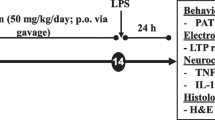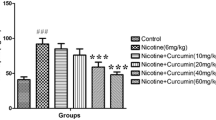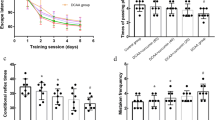Abstract
The aim of the present study was to investigate the protective effects of curcumin alone and in combination with piperine against lipopolysaccharide (LPS)-induced neurobehavioral and neurochemical deficits in the mice hippocampus. Mice were treated with curcumin (100, 200, and 400 mg/kg, p.o.) and piperine (20 mg/kg, p.o.) for 7 days followed by LPS (0.83 mg/kg, i.p.) administration. Animals exhibited anxiety and depressive-like phenotype after 3 and 24 h of LPS exposure, respectively. LPS administration increased the oxido-nitrosative stress as evident by elevated levels of malondialdehyde, nitrite, and depletion of glutathione level in the hippocampus. Furthermore, we found raised level of pro-inflammatory cytokines (IL-1β and TNF-α) in the hippocampus of LPS-treated mice. Pretreatment with curcumin alleviated LPS-induced neurobehavioral and neurochemical deficits. Furthermore, co-administration of curcumin with piperine significantly potentiated the neuroprotective effect of curcumin. These results demonstrate that piperine enhanced the neuroprotective effect of curcumin against LPS-induced neurobehavioral and neurochemical deficits.








Similar content being viewed by others
References
Jangra, A., M.M. Lukhi, K. Sulakhiya, et al. 2014. Protective effect of mangiferin against lipopolysaccharide-induced depressive and anxiety-like behaviour in mice. European Journal of Pharmacology 740: 337–345.
World Health Organization (2012). Retrieved from http://www.who.int/mediacentre/factsheets/fs369/en/.
Hurley, L.L., and Y. Tizabi. 2013. Neuroinflammation, neurodegeneration, and depression. Neurotoxicology Research 23: 131–144.
Uher, R., O. Mors, M. Rietschel, et al. 2011. Early and delayed onset of response to antidepressants in individual trajectories of change during treatment of major depression: a secondary analysis of data from the Genome-Based Therapeutic Drugs for Depression (GENDEP) study. Journal of Clinical Psychiatry 72: 1478–1484.
Sriram, C.S., A. Jangra, S.S. Gurjar, et al. 2015. Poly (ADP-ribose) polymerase-1 inhibitor, 3-aminobenzamide pretreatment ameliorates lipopolysaccharide-induced neurobehavioral and neurochemical anomalies in mice. Pharmacology Biochemistry Behavior 133: 83–91.
Manji, H.K., W.C. Drevets, and D.S. Charney. 2001. The cellular neurobiology of depression. Nature Medicine 7: 541–547.
Maes, M., R. Yirmyia, J. Noraberg, et al. 2009. The inflammatory & neurodegenerative (I&ND) hypothesis of depression: leads for future research and new drug developments in depression. Metabolic Brain Disease 24: 27–53.
Raison, C.L., and A.H. Miller. 2011. Is depression an inflammatory disorder? Current Psychiatry Reports 13: 467–475.
Leonard, B., and M. Maes. 2012. Mechanistic explanations how cell-mediated immune activation, inflammation and oxidative and nitrosative stress pathways and their sequels and concomitants play a role in the pathophysiology of unipolar depression. Neuroscience & Biobehavioral Reviews 36: 764–785.
Liu, Y., R.C. Ho, and A. Mak. 2012. Interleukin (IL)-6, tumour necrosis factor alpha (TNF-α) and soluble interleukin-2 receptors (sIL-2R) are elevated in patients with major depressive disorder: a meta-analysis and meta-regression. Journal of Affective Disorders 139: 230–239.
Leonard, B.E., and A. Myint. 2006. Inflammation and depression: is there a causal connection with dementia? Neurotoxicology Research 10: 149–60.
Hemmerle, A.M., J.P. Herman, and K.B. Seroogy. 2012. Stress, depression and Parkinson’s disease. Experimental Neurology 233: 79–86.
Song, C., and H. Wang. 2011. Cytokines mediated inflammation and decreased neurogenesis in animal models of depression. Progress in Neuro-Psychopharmacology & Biological Psychiatry 35: 760–768.
Godbout, J.P., J. Chen, J. Abraham, et al. 2005. Exaggerated neuroinflammation and sickness behavior in aged mice following activation of the peripheral innate immune system. FASEB Journal 19: 1329–1331.
Huang, Y., C.J. Henry, R. Dantzer, et al. 2007. Exaggerated sickness behavior and brain proinflammatory cytokine expression in aged mice in response to intracerebroventricular lipopolysaccharide. Neurobiology of Aging 29: 1744–1753.
Sugino, K., K. Dohi, K. Yamada, et al. 1987. The role of lipid peroxidation in endotoxin-induced hepatic damage and the protective effect of antioxidants. Surgery 101: 746–752.
Guan, Z., and J. Fang. 2006. Peripheral immune activation by lipopolysaccharide decreases neurotrophins in the cortex and hippocampus in rats. Brain Behavior and Immunity 20: 64–71.
Singh, S., S. Jamwal, and P. Kumar. 2015. Piperine enhances the protective effect of curcumin against 3-NP induced neurotoxicity: possible neurotransmitters modulation mechanism. Neurochemical Research 40: 1758–1766.
Noorafshan, A., and S. Ashkani-Esfahani. 2013. A review of therapeutic effects of curcumin. Current Pharmaceutical Design 19: 2032–2046.
Srimal, R.C., and B.N. Dhawan. 1973. Pharmacology of diferuloyl methane (curcumin), a non-steroidal anti-inflammatory agent. Journal of Pharmacy and Pharmacology 25: 447–452.
Kiso, Y., Y. Suzuki, N. Watanabe, et al. 1983. Antihepatotoxic principles of Curcuma longa rhizomes. Planta Medica 49: 185–187.
Ruby, A.J., G. Kuttan, K.D. Babu, et al. 1995. Anti-tumour and antioxidant activity of natural curcuminoids. Cancer Letter. 94: 79–83.
Venkatesan, N., D. Punithavathi, and V. Arumugam. 2000. Curcumin prevents adriamycin nephrotoxicity in rats. British Journal of Pharmacology 129: 231–234.
Calabrese, V., T.E. Bates, C. Mancuso, et al. 2008. Curcumin and the cellular stress response in free radical-related diseases. Molecular Nutrition & Food Research 52: 1062–1073.
De, R., P. Kundu, S. Swarnakar, et al. 2009. Antimicrobial activity of curcumin against Helicobacter pylori isolates from India and during infections in mice. Antimicrobial Agents and Chemotherapy 53: 1592–1597.
Nafisi, S., M. Adelzadeh, Z. Norouzi, et al. 2009. Curcumin binding to DNA and RNA. DNA Cell Biology 28: 201–208.
Xu, Y., D. Lin, S. Li, et al. 2009. Curcumin reverses impaired cognition and neuronal plasticity induced by chronic stress. Neuropharmacology 57: 463–71.
Mancuso, C., R. Siciliano, E. Barone, et al. 2012. Natural substances and Alzheimer’s disease: from preclinical studies to evidence based medicine. Biochimica et Biophysica Acta 1822: 616–624.
Kumar, A., S. Dogra, and A. Prakash. 2009. Protective effect of curcumin (Curcuma longa), against aluminium toxicity: Possible behavioral and biochemical alterations in rats. Behavioural Brain Research 205: 384–390.
Pattanaik, S., D. Hota, and S. Prabhakar. 2009. Pharmacokinetic interaction of single dose of piperine with steady-state carbamazepine in epilepsy patients. Phytotherapy Research 23: 1281–1286.
Rinwa, P., and A. Kumar. 2012. Piperine potentiates the protective effects of curcumin against chronic unpredictable stress-induced cognitive impairment and oxidative damage in mice. Brain Research 1488: 38–50.
Espejo, E.F. 1997. Effects of weekly or daily exposure to the elevated plus-maze in male mice. Behavioral Brain Research 87: 233–238.
Bassi, G.S., A. Kanashiro, F.M. Santin, et al. 2012. Lipopolysaccharide-induced sickness behaviour evaluated in different models of anxiety and innate fear in rats. Basic & Clinical Pharmacology & Toxicology 110: 359–369.
Lacosta, S., Z. Merali, and H. Anisman. 1999. Behavioral and neurochemical consequences of lipopolysaccharide in mice: anxiogenic-like effects. Brain Research 818: 291–303.
Steru, L., R. Chermat, B. Thierry, et al. 1985. The tail suspension test: a new method for screening antidepressants in mice. Psychopharmacology (Berl) 85: 367–370.
Porsolt, R., A. Bertin, and M. Jalfre. 1977. Behavioral despair in mice: a primary screening test for antidepressants. Archives Internationales de Pharmacodynamie et de Thérapie 229: 327–336.
Jangra, A., A.K. Datusalia, S. Khandwe, et al. 2013. Amelioration of diabetes-induced neurobehavioral and neurochemical changes by melatonin and nicotinamide: implication of oxidative stress-PARP pathway. Pharmacology Biochemistry Behavior 114–115: 43–51.
Beutler, E., O. Duron, and B.M. Kelly. 1963. Improved method for the determination of blood glutathione. Journal of Laboratory and Clinical Medicine 61: 882–888.
Lowry, O.H., N.J. Rosebrough, A.L. Farr, et al. 1951. Protein measurement with the Folin phenol reagent. Journal of Biological Chemistry 193: 265–275.
Green, L.C., D.A. Wagner, J. Glogowski, et al. 1982. Analysis of nitrate, nitrite, and [15N] nitrate in biological fluids. Analytical Biochemistry 126: 131–138.
Maes, M. 1995. Evidence for an immune response in major depression: a review and hypothesis. Progress in Neuro-Psychopharmacology & Biological Psychiatry 19: 11–38.
Dunbar, P., J. Hill, T. Neale, et al. 1992. Neopterin measurement provides evidence of altered cell-mediated immunity in patients with depression, but not with schizophrenia. Psychological Medicine 22: 1051–1057.
Hestad, K.A., S. Tønseth, C.D. Støen, et al. 2003. Raised plasma levels of tumor necrosis factor [alpha] in patients with depression: normalization during electroconvulsive therapy. Journal ECT 19: 183–188.
Moylan, S., M. Maes, N.R. Wray, et al. 2012. The neuroprogressive nature of major depressive disorder: pathways to disease evolution and resistance, and therapeutic implications. Molecular Psychiatry 18: 595–606.
Swiergiel, A.H., and A.J. Dunn. 2007. Effects of interleukin-1β and lipopolysaccharide on behavior of mice in the elevated plus-maze and open field tests. Pharmacology Biochemistry Behavior 86: 651–659.
Biesmans, S., T.F. Meert, J.A. Bouwknecht, et al. 2013. Systemic immune activation leads to neuroinflammation and sickness behavior in mice. Mediators of inflammation 2013:2013:271359.
Sriram, C.S., A. Jangra, S.S. Gurjar, et al. 2016. Edaravone abrogates LPS-induced behavioral anomalies, neuroinflammation and PARP-1. Physiology Behavior. 154: 135–144.
Sulakhiya, K., G.P. Keshavlal, B.B. Bezbaruah, et al. 2016. Lipopolysaccharide induced anxiety- and depressive-like behaviour in mice are prevented by chronic pre-treatment of esculetin. Neuroscience Letters 611: 106–111.
Lawson, M.A., J.M. Parrott, R.H. McCusker, et al. 2013. Intracerebroventricular administration of lipopolysaccharide induces indoleamine-2,3-dioxygenase-dependent depression-like behaviors. Journal of Neuroinflammation 10: 87.
Dantzer, R., J.C. O’Connor, G.G. Freund, et al. 2008. From inflammation to sickness and depression: when the immune system subjugates the brain. Nature Review of Neuroscience 9: 46–56.
O’Connor, J.C., M.A. Lawson, C. André, et al. 2009. Lipopolysaccharide-induced depressive-like behavior is mediated by indoleamine 2,3-dioxygenase activation in mice. Molecular Psychiatry 14: 511–522.
Walker, A.K., D.P. Budac, S. Bisulco, et al. 2013. NMDA receptor blockade by ketamine abrogates lipopolysaccharide-induced depressive-like behavior in C57BL/6J mice. Neuropsychopharmacology 38: 1609–1616.
Berkenbosch, F., J. van Oers, A. del Rey, et al. 1987. Corticotropin-releasing factor producing neurons in the rat activated by interleukin-1. Science 238: 524–526.
Reichenberg, A., T. Kraus, M. Haack, et al. 2002. Endotoxin-induced changes in food consumption in healthy volunteers are associated with TNF-alpha and IL-6 secretion. Psychoneuroendocrinology 27: 945–956.
Sulakhiya, K., P. Kumar, A. Jangra, et al. 2014. Honokiol abrogates lipopolysaccharide-induced depressive like behavior by impeding neuroinflammation and oxido-nitrosative stress in mice. European Journal of Pharmacolology 744: 124–131.
Jiang, H., Z. Wang, Y. Wang, et al. 2013. Antidepressant-like effects of curcumin in chronic mild stress of rats: involvement of its anti-inflammatory action. Progress in Neuro-Psychopharmacology & Biological Psychiatry 47: 33–39.
Rinwa, P., A. Kumar, and S. Garg. 2013. Suppression of neuroinflammatory and apoptotic signaling cascade by curcumin alone and in combination with piperine in rat model of olfactory bulbectomy induced depression. PLoS One 8, e61052.
Sharma, O.P. 1976. Antioxidant activity of curcumin and related compounds. Biochemical Pharmacology 25: 1811–1812.
Sidhu, G.S., A.K. Singh, D. Thaloor, et al. 1998. Enhancement of wound healing by curcumin in animals. Wound Repair and Regeneration 6: 167–177.
Negi, P.S., G.K. Jayaprakasha, R. Jagan Mohan, et al. 1999. Antibacterial activity of turmeric oil: a byproduct from curcumin manufacture. Journal of Agricultural and Food Chemistry 47: 4297–4300.
Mukerjee, A., and J.K. Vishwanatha. 2009. Formulation, characterization and evaluation of curcumin-loaded PLGA nanospheres for cancer therapy. Anticancer Research 29: 3867–3875.
Shaikh, J., D.D. Ankola, V. Beniwal, et al. 2009. Nanoparticle encapsulation improves oral bioavailability of curcumin by at least 9-fold when compared to curcumin administered with piperine as absorption enhancer. European Journal Pharmaceutical Science 37: 223–230.
Takahashi, M., S. Uechi, K. Takara, et al. 2009. Evaluation of an oral carrier system in rats: bioavailability and antioxidant properties of liposome-encapsulated curcumin. Journal of Agricultural and Food Chemistry 57: 9141–9146.
Klippstein, R., J.T. Wang, R.I. El-Gogary, et al. 2015. Passively targeted curcumin-loaded PEGylated PLGA nanocapsules for colon cancer therapy in vivo. Small 11: 4704–4722.
Anand, P., A.B. Kunnumakkara, R.A. Newman, et al. 2007. Bioavailability of curcumin: problems and promises. Molecular Pharmacology 4: 807–818.
Kesarwani, K., and R. Gupta. 2013. Bioavailability enhancers of herbal origin: an overview. Asian Pacific Journal of Tropical Biomedicine 3: 253–266.
Rinwa, P., and A. Kumar. 2013. Quercetin along with piperine prevents cognitive dysfunction, oxidative stress and neuro-inflammation associated with mouse model of chronic unpredictable stress. Archives of Pharmacal Research 2013: 2013.
Atal, C.K., R.K. Dubey, and J.J. Singh. 1985. Biochemical basis of enhanced drug bioavailability by piperine: evidence that piperine is a potent inhibitor of drug metabolism. Journal of Pharmacology and Experimental Therapeutics 232: 258–262.
Prasad, S., A.K. Tyagi, and B.B. Aggarwal. 2014. Recent developments in delivery, bioavailability, absorption and metabolism of curcumin: the golden pigment from golden spice. Cancer Research and Treatment 46: 2–18.
Clementi, E., G.C. Brown, M. Feelisch, et al. 1998. Persistent inhibition of cell respiration by nitric oxide: crucial role of S-nitrosylation of mitochondrial complex I and protective action of glutathione. Proceedings of the National Academy of Sciences 95: 7631–7636.
Jezek, P., and L. Hlavata. 2005. Mitochondria in homeostasis of reactive oxygen species in cell, tissues, and organism. International Journal of Biochemistry & Cell Biology 37: 2478–2503.
Lijuan, B., X. Zhang, L. Xiaohong, et al. 2015. Somatostatin prevents lipopolysaccharide-induced neurodegeneration in the rat substantia nigra by inhibiting the activation of microglia. Molecular Medicine Report 12: 1002–1008.
Miller, A.H., V. Maletic, and C.L. Raison. 2009. Inflammation and its discontents: the role of cytokines in the pathophysiology of major depression. Biological psychiatry 65: 732–741.
Betancur, C., J. Borrell, and C. Guaza. 1995. Cytokine regulation of corticosteroid receptors in the rat hippocampus: effects of interleukin-1, interleukin-6, tumor necrosis factor and Lipopolysaccharide. Neuroendocrinology 62: 47–54.
Reincke, M., B. Allolio, G. Würth, et al. 1993. The hypothalamic-pituitary-adrenal axis in critical illness: response to dexamethasone and corticotropin-releasing hormone. Journal of Clinical Endocrinology & Metabolism 77: 151–156.
Beishuizen, A., and L.G. Thijs. 2003. Endotoxin and the hypothalamo-pituitary-adrenal (HPA) axis. Journal of Endotoxin Research 9: 3–24.
Erkut, Z.A., E. Endert, I. Huitinga, et al. 2002. Cortisol is increased in postmortem cerebrospinal fluid of multiple sclerosis patients: relationship with cytokines and sepsis. Multiple Sclerosis 8: 229–236.
Cubała, W.J., and J. Landowski. 2005. Serotoninergic system and limbic-hypothalamic-pituitary-adrenal axis (LHPA axis) in depression. Psychiatria polska 40: 415–430.
Sen, S., R. Duman, and G. Sanacora. 2008. Serum BDNF, depression and anti-depressant medications: meta-analyses and implications. Biological Psychiatry 64: 527–532.
Basterzi, A.D., K. Yazici, E. Aslan, et al. 2009. Effects of fluoxetine and venlafaxine on serum brain derived neurotrophic factor levels in depressed patients. Progress in Neuro-Psychopharmacology & Biological Psychiatry 33: 281–285.
Varambally, S., G.H. Naveen, M.G. Rao, et al. 2013. Low serum brain derived neurotrophic factor in non-suicidal out-patients with depression: relation to depression scores. Indian Journal of Psychiatry 55(Suppl 3): S397–S399.
Xu, Y., B.S. Ku, L. Tie, et al. 2006. Curcumin reverses the effects of chronic stress on behavior, the HPA axis. BDNF expression and phosphorylation of CREB. Brain Research. 1122: 56–64.
Li, S., C. Wang, M. Wang, et al. 2007. Antidepressant like effects of piperine in chronic mild stress treated mice and its possible mechanisms. Life Sciences 15: 1373–1381.
Jacobsen, J.P., and A. Mørk. 2006. Chronic corticosterone decreases brain-derived neurotrophic factor (BDNF) mRNA and protein in the hippocampus, but not in the frontal cortex of the rat. Brain Research 1110: 221–225.
Huang, Z., X.M. Zhong, Z.Y. Li, et al. 2011. Curcumin reverses corticosterone-induced depressive-like behavior and decrease in brain BDNF levels in rats. Neuroscience Letters 493: 145–148.
Jangra, A., S. Dwivedi, C.S. Sriram, et al. 2015. Honokiol abrogates chronic restraint stress-induced cognitive impairment and depressive-like behaviour by blocking endoplasmic reticulum stress in the hippocampus of mice. European Journal of Pharmacology 770: 25–32.
Jangra, A., C.S. Sriram, S. Dwivedi, et al. 2016. Sodium Phenylbutyrate and Edaravone Abrogate Chronic Restraint Stress-Induced Behavioral Deficits: Implication of Oxido-Nitrosative, Endoplasmic Reticulum Stress Cascade, and Neuroinflammation. Cellular and Molecular Neurobiology. doi:10.1007/s10571-016-0344-5.
Acknowledgements
We would like to thank the Department of Pharmaceuticals, Ministry of Chemicals and Fertilizers, Government of India, for financial support. The authors are immensely thankful to the Institutional Level Biotech hub, NIPER Guwahati for providing technical support.
Author information
Authors and Affiliations
Corresponding author
Additional information
Conflict of Interest
The authors declare no financial or commercial conflict of interest
Rights and permissions
About this article
Cite this article
Jangra, A., Kwatra, M., Singh, T. et al. Piperine Augments the Protective Effect of Curcumin Against Lipopolysaccharide-Induced Neurobehavioral and Neurochemical Deficits in Mice. Inflammation 39, 1025–1038 (2016). https://doi.org/10.1007/s10753-016-0332-4
Published:
Issue Date:
DOI: https://doi.org/10.1007/s10753-016-0332-4




